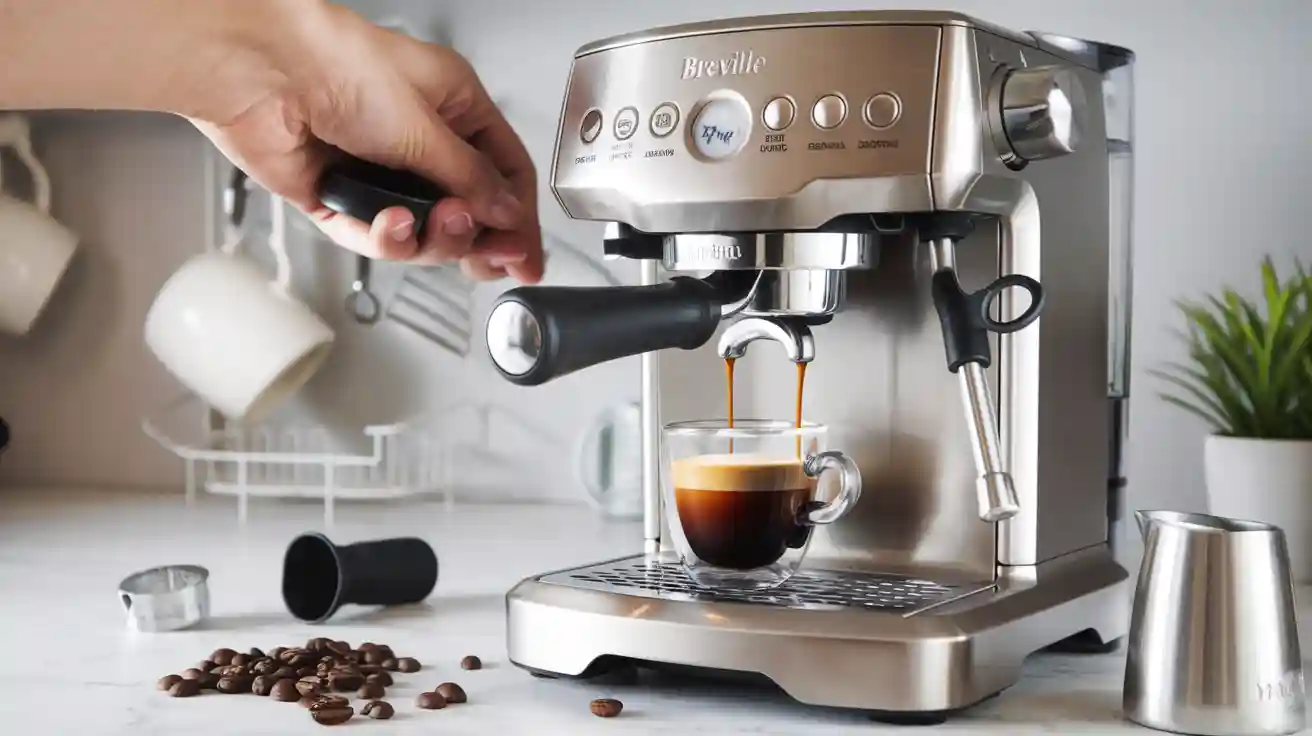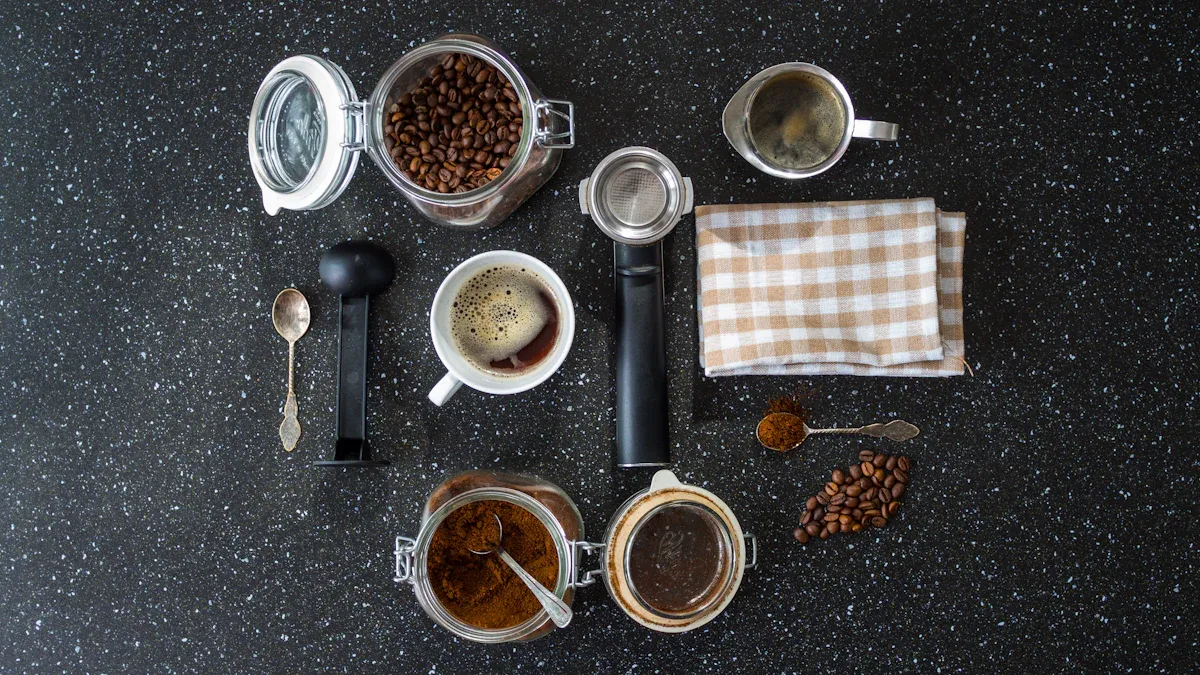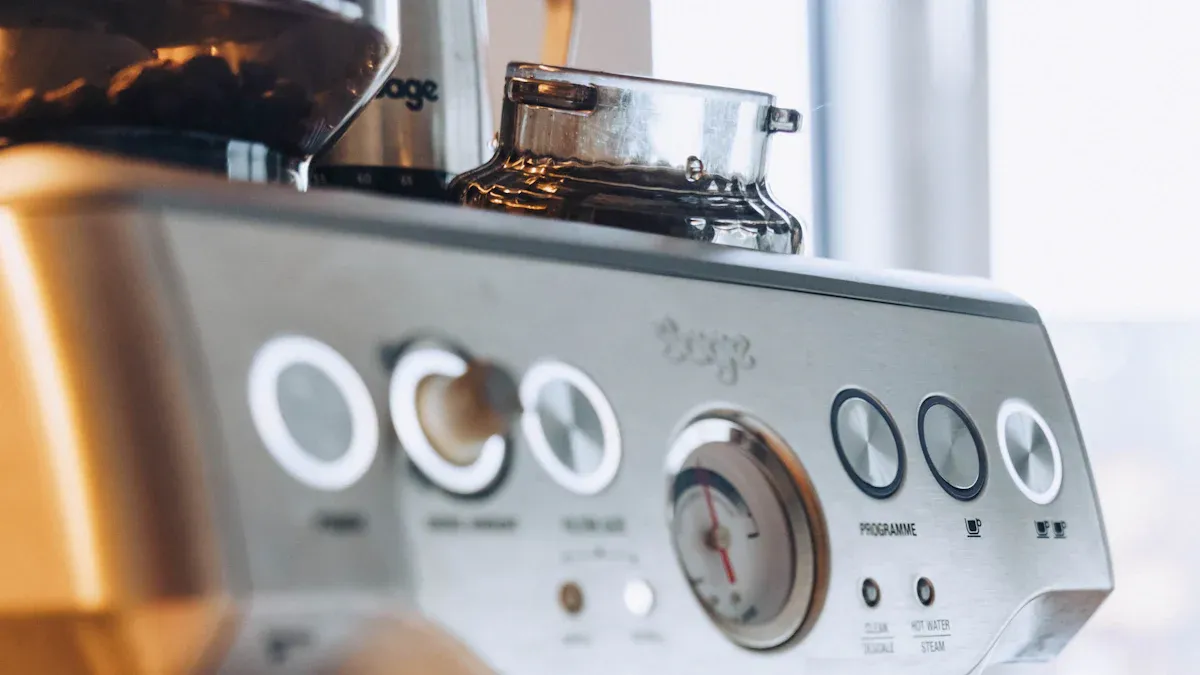
You want café-quality drinks at home, right? The breville barista express espresso machine bes870xl lets you create perfect espresso every time. With this espresso machine, you control every step. Start pulling a perfect shot and enjoy barista-level results. The breville barista express truly stands out as the best home espresso machine for café-quality drinks. This step-by-step guide puts you in charge.
Essential Tools and Ingredients for Perfect Espresso

Must-Have Accessories for the Breville Barista Express
You want to get the most out of your breville barista express. The right accessories make a big difference. Here’s a quick list of must-haves that help you brew espresso like a pro:
- Portafilter: Holds your coffee grounds steady during brewing.
- Tamper: Packs the grounds evenly for a smooth shot.
- Digital scale: Measures coffee and water for perfect dosing.
- Knock box: Lets you toss used grounds fast and easy.
- Grinder: Gives you control over the grind, which is key for flavor.
- Milk pitcher: Helps you steam milk for lattes and cappuccinos.
- Timer: Tracks your shot time for consistency.
- Shot glass: Measures your espresso volume.
- Tamping mat: Keeps your counter safe and steady.
- WDT tool: Spreads grounds evenly for better extraction.
Tip: A dosing funnel keeps your counter clean and helps you get the right amount of coffee in the portafilter.
Selecting Fresh Coffee Beans for the Perfect Shot
You can’t make great espresso without high-quality coffee beans. Always choose fresh roasted beans. Freshness matters because it keeps the flavors bright and the aroma strong. Studies show that beans stored at cooler temperatures keep their taste and smell longer. If you store your beans in a cool, dry place, you’ll notice better crema and richer flavor in every cup. Try to use your beans within a month of roasting for the best results.
Tip: Buy whole beans and grind them right before brewing. This keeps your espresso tasting fresh and lively.
Using Filtered Water for Better Espresso
Water makes up most of your espresso. Using filtered water helps you avoid odd flavors and keeps your breville barista express running smoothly. Many top baristas use special mineral blends to get the best taste. Clean water brings out the natural sweetness and balance in your shot. You’ll also protect your machine from scale buildup.
Preparing the Breville Barista Express Espresso Machine BES870XL
Filling the Water Tank and Preheating
Before you start making espresso, you need to fill the water tank on your Breville Barista Express. Always use the machine in tank mode if it has a water reservoir. This helps the espresso machine heat up properly and keeps things safe. Don’t use distilled, purified, or reverse osmosis water. These can actually harm your machine and mess with the taste of your espresso. Stick with filtered water for the best results.
Tip: If you want to keep your machine running smoothly, use a water treatment system. This helps prevent limescale buildup and keeps your espresso tasting great.
Once you fill the tank, turn on your Breville Barista Express. Let it preheat for at least 10-15 minutes. Preheating makes sure the water and all the metal parts reach the right temperature. This step helps you pull a better shot every time.
Cleaning the Portafilter and Group Head
You want every shot of espresso to taste fresh and delicious. That means you need to clean the portafilter and group head before you brew. Wipe down the portafilter to remove old coffee grounds and oils. Run a quick water shot through the group head to clear out any leftover residue.
Regular cleaning keeps your espresso machine working well and your drinks tasting great. Experts say daily cleaning stops coffee oils and gunk from building up. If you clean your portafilter and group head after each use, you’ll avoid sour or bitter flavors. Weekly deep cleaning, like soaking metal parts and backflushing, helps your Breville Barista Express last longer and perform better.
Remember: Clean machines make better espresso and save you from costly repairs down the road.
Grinding and Dosing with the Breville Barista Express
Setting the Right Grind Size
Getting the right grind is one of the most important steps when you use the breville barista express. If you want to know how to use this machine for great espresso, you need to pay attention to grind size and amount. The grind setting changes how fast water flows through your coffee. Too fine, and your espresso tastes bitter. Too coarse, and it turns out sour or watery.
Here’s a quick look at how different grind settings affect your espresso:
| Grind Setting (Scale) | Brew Method | Flow Rate (g/s) | Extraction Yield (%) | Taste Description |
|---|---|---|---|---|
| 1.5 | Espresso | 0.9 | 21 | Over-extracted, bitter |
| 4.5 | Filter | 1.2 | 18.8 | Balanced extraction |
| 7.5 | French Press | 1.5 | 15 | Under-extracted, sour |
You want to start with a fine grind for espresso. The breville barista express lets you adjust the grind easily. Try a few settings and see what works best for your beans. Many baristas check and adjust the grind every day because things like humidity and bean type can change how your espresso tastes.
Tip: If you change the dose or basket size, you may need to adjust the grind again for the best shot.
Weighing and Grinding Fresh Coffee
Freshness matters a lot when you make espresso. Always weigh your coffee before you grind the coffee. Most people use about 18-20 grams for a double shot. The breville barista express has a built-in grinder, so you can grind right before brewing. This keeps your espresso tasting bright and full.
Studies show that grinding fresh beans right before brewing gives you better flavor. Coffee loses its taste quickly after grinding. If you want to know how to use your machine for the best results, always use fresh beans and grind them just before brewing. Scientists found that the amount of tiny coffee particles, called fines, changes how your espresso extracts. The right grind helps you get a smooth, rich shot every time.
Note: Weighing your coffee and using the right grind size and amount will help you get consistent results with your breville barista express.
Distributing and Tamping for a Perfect Shot of Espresso
Evenly Distributing Coffee Grounds
You want every shot of espresso to taste rich and balanced. Start by making sure the coffee grounds in your portifilter are spread out evenly. If you skip this step, water will rush through loose spots and create channels. This causes some parts of your espresso puck to get over-extracted and others to stay under-extracted. You end up with a bitter or bland drink.
When you use a WDT tool or similar tricks, you break up clumps and fix static issues. This helps water flow smoothly through the coffee bed. Research shows that even distribution keeps extraction times in the sweet spot of 25-30 seconds. You get a stable puck, no air pockets, and a better shot every time. Expert baristas say that these techniques help you control the flow and flavor of your espresso. If you hold the portifilter at an angle or skip proper distribution, you risk uneven density and channeling.
Tip: Always tap the portifilter gently on the counter before tamping. This settles the grounds and makes tamping easier.
Tamping Technique and Pressure Tips
Tamping is the next key step. You want to press the coffee grounds down with steady, even pressure. Aim for about 30 pounds of force. Hold the tamper straight and push down until the surface looks smooth and crack-free. Don’t twist the tamper at the end.
Here’s a quick look at how tamping affects your espresso:
| Aspect | Proper Tamping | Improper/Light Tamping |
|---|---|---|
| Extraction Time | 25-30 seconds (optimal) | 10-15 seconds (too fast) |
| Flavor Balance | Sweet, balanced, complex | Sour, sharp, simple |
| Crema | Thick, persistent, golden | Thin, pale, quick to fade |
| Mouthfeel | Rich, viscous | Watery, thin |
| Consistency | Reliable shot-to-shot | Unpredictable results |
If you tamp right, you get a thick crema and a sweet, balanced espresso. Light or uneven tamping leads to fast flow, poor crema, and weak flavor. Try using a calibrated tamper for more reliable results. These tips and tricks will help you get the most from your grind and portifilter every time.
Pulling a Perfect Shot with the Breville Barista Express

Locking in the Portafilter Securely
You have done all the prep work—now it is time to lock in the portifilter. Hold the handle straight and fit it into the group head of your Breville Barista Express. Turn the portifilter firmly to the right until it feels snug. You want a tight seal so water does not leak out during brewing. If you do not lock it in all the way, you might get a weak or messy shot.
A preheated portafilter helps keep your espresso hot and stable. Always make sure the portafilter is dry before you add the coffee grounds. Wet baskets can cause the grounds to stick and ruin the tamp. When you lock in the portafilter, you set the stage for a uniform extraction and a perfect shot of espresso.
Tip: Wipe the rim of the portafilter before locking it in. This keeps the seal clean and helps prevent leaks.
Using Pre-Infusion Mode
The Breville Barista Express espresso machine BES870XL has a pre-infusion mode that makes a big difference. When you start the shot, the machine gently soaks the coffee puck with low-pressure water. This step helps the grounds bloom and settle before full pressure kicks in. Pre-infusion reduces channeling, which means water flows evenly through the coffee bed. You get a smoother, richer espresso with better flavor and thicker crema.
Experts say pre-infusion leads to more even saturation and consistent espresso shots. The low pressure at the start (about 1-2 bars) lets the coffee absorb water slowly. Then, the machine ramps up to full pressure (9 bars) to extract the espresso. Studies show that using pre-infusion lowers the chance of channeling and dead spots in the puck. You will notice a more stable flow and fewer bitter or sour notes in your cup.
Tip: Let pre-infusion run for a few seconds before full extraction. Watch for the coffee to darken and start dripping evenly.
Monitoring Extraction Time and Flow
Now you are ready for the most exciting part—pulling a perfect shot. Press the brew button and watch the espresso flow. Keep an eye on the extraction time. Most baristas aim for 25-30 seconds for a double shot. If the shot runs too fast, your espresso will taste sour and thin. If it runs too slow, you might get bitter flavors.
You can use a timer or the built-in shot clock on your Breville Barista Express. Watch the color of the stream. When it starts to turn yellowish or pale (this is called “blonding“), it is time to stop the shot. Blonding means you have pulled out the best flavors, and anything more will taste bitter.
Scientific studies show that controlling extraction time and flow gives you more consistent results. The flow rate depends on your grind size, tamping, and dose. If you grind finer, the flow slows down and extraction time increases. If you grind coarser, the shot runs faster. The right balance brings out sweetness, juiciness, and the unique taste of your coffee beans.
Tricks: Use a bottomless portafilter to see how the espresso flows. This helps you spot channeling and improve your technique.
A good shot will have a thick, golden crema and a steady, even flow. If you see spurts or uneven streams, check your grind and tamping. With practice, you will learn to brew espresso that tastes just like your favorite café.
Tip: Always use filtered water and keep your grinder clean. This keeps flavors fresh and your machine running strong.
When you follow these steps, you can pull a perfect shot every time. The Breville Barista Express gives you control over every detail, from grind to flow. You will soon master how to extract the espresso and steam and froth the milk for delicious drinks at home.
Evaluating and Adjusting Your Perfect Espresso
Checking Crema and Taste
When you finish pulling your espresso shot, take a close look at the crema. A thick layer of crema tells you that your espresso is fresh and well-extracted. You want to see a golden-brown or caramel color, not pale or spotty. The crema should last at least a minute and feel velvety or silky.
Here’s a quick table showing how different beans create crema:
| Espresso Bean Brand | Crema Thickness (mm) | Persistence Duration | Crema Color | Texture Description |
|---|---|---|---|---|
| Lavazza Super Crema | 3-4 | Over 2 minutes | Golden-brown | Velvety |
| Illy Classico | 2-3 | 1.5 minutes | Hazelnut | Fine bubbles |
| Kimbo Espresso Napoletano | 4-5 | 2.5 minutes | Dark amber | Dense |
| Miscela d’Oro Gran Crema | 3 | 1.75 minutes | Caramel | Silky |
| Segafredo Zanetti | 2-3 | 1.25 minutes | Medium brown | Medium texture |
A beautiful crema means your beans are fresh and your technique is solid. When you taste your espresso, look for a balance of sweetness, acidity, and a rich body. Expert panels use special tasting methods to check for flavor complexity and aroma. They also test for consistency across different bags and brewing styles. If your espresso tastes flat or bitter, you might need to adjust your grind or dose.
Tip: Aroma and flavor change with grind size, water temperature, and extraction time. Try small tweaks to find your favorite taste.
Troubleshooting Common Espresso Issues
Sometimes things go wrong with espresso shots. Don’t worry—most problems have simple fixes. Here are some common issues and what you can do:
- No espresso comes out: Check if the water tank is full and the machine is on. Make sure the portafilter is locked in place.
- Weak or watery espresso: Try a finer grind or use more coffee. Make sure you tamp firmly.
- Bitter taste: Use a coarser grind or shorten the extraction time.
- Sour taste: Use a finer grind or increase the extraction time.
- Thin crema: Use fresher beans or try a blend with more Robusta.
Troubleshooting guides from commercial coffee shops show that most problems come from grind size, tamping, or water flow. You can get consistent results by making small changes and testing each shot. If you see leaks or steam wand issues, check for clogs or clean the parts.
Note: Keep your machine clean and use fresh beans for the best espresso every time.
Troubleshooting and Fine-Tuning the Breville Barista Express
Adjusting Grind Size and Dose
You want your breville barista express to deliver great espresso every time. Start by checking your grind size. If your shot tastes sour or runs too fast, try a finer grind. If it tastes bitter or takes too long, go coarser. Adjust the dose, too. More coffee in the portafilter can slow down the flow, while less coffee speeds it up. Use your scale to measure the dose for consistent results. Small changes can make a big difference in flavor.
Tip: Make one change at a time. This helps you see what works best for your espresso.
Solving Fast or Slow Extraction
Sometimes your espresso flows too quickly or too slowly. This can happen even if you follow all the steps. Scientific studies show that grind size, flow rate, and water temperature all affect extraction. Finer grinds increase surface area and help pull out more flavor, but they can also slow down the shot. If your espresso runs fast, try a finer grind or increase your dose. If it runs slow, use a coarser grind or lower the dose. Watch the shot as it brews. The breville barista express lets you adjust these settings easily. Remember, most of the flavor comes out early in the shot, so keep an eye on the color and flow.
Tricks: Use the built-in pressure gauge to help you spot problems with flow.
Improving Crema and Flavor
You want thick, golden crema and rich flavor in every cup. Fresh beans and the right grind help a lot. Try different beans and see which ones give you the best crema. Clean your breville barista express often to avoid bitter flavors. Use filtered water for a sweeter taste. If your crema looks thin, check your grind and dose. Try new techniques, like adjusting tamp pressure or using a WDT tool, to improve your results.
Tips: Taste your espresso after each adjustment. Write down what you change so you can repeat your best shots.
Cleaning and Maintaining the Breville Barista Express Espresso Machine BES870XL
Daily Cleaning Essentials
You want your espresso to taste great every time. That means you need to clean your breville barista express after each use. Daily cleaning keeps your espresso machine running smoothly and helps you avoid bitter flavors.
Here’s a simple daily cleaning routine:
- Purge the group head right after pulling a shot. This flushes out coffee grounds and oils that can build up and hurt your next espresso.
- Wipe down the portafilter and brew group screen after every shot. This keeps old grounds from sticking around.
- Run a quick water rinse through the brew group screen to clear out any leftover grounds.
- Purge the steam wand before and after steaming milk. This stops milk from clogging the wand and keeps your drinks tasting fresh.
- Wipe the steam wand clean right after use. You don’t want milk residue to dry and block it.
- Perform a daily backflush with water. This helps prevent machine issues and keeps everything clean.
Tip: Regular cleaning not only keeps your espresso tasting good but also helps your breville barista express last longer.
Deep Cleaning and Maintenance Tips
Deep cleaning your breville barista express espresso machine bes870xl is just as important as daily care. You should follow the manufacturer’s guide for deep cleaning and maintenance. This helps your espresso machine work better and last longer.
- Schedule deep cleaning based on how often you use your machine. Heavy use means more frequent cleaning.
- Use the right cleaning products and follow the instructions in your manual.
- Replace worn parts like gaskets and filters as needed.
- Keep a cleaning checklist or set reminders so you don’t forget important steps.
- Track your cleaning and maintenance in a notebook or app. This helps you spot patterns and fix problems early.
- Get your espresso machine checked by a professional once in a while. They can catch issues you might miss.
A well-maintained breville barista express uses less energy and makes better espresso. You also avoid costly repairs and keep your warranty safe. Good cleaning habits help you enjoy delicious espresso at home for years.
You can pull a perfect espresso shot at home with practice and patience. Experts say fresh beans, the right grind, and clean tools matter most. Try new settings and taste each shot. ☕
Remember: Adjusting dose and timing helps you find your favorite flavor every time.
FAQ
How often should you clean your Breville Barista Express?
You should clean your machine every day after use. Deep clean it once a month. This keeps your espresso tasting fresh and your machine running well.
What grind size works best for espresso?
Start with a fine grind, like table salt. Adjust finer or coarser if your shot runs too fast or too slow. Fresh beans make a big difference.
Why does your espresso taste bitter?
Bitter espresso usually means your grind is too fine or your shot takes too long. Try a coarser grind or shorten the extraction time for a smoother taste.


